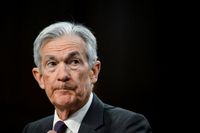On Wednesday, May 7, 2025, the Federal Reserve (Fed) decided to keep interest rates unchanged, remaining in the range of 4.25% to 4.5%. This marks the third consecutive meeting where rates have been held steady, reflecting the central bank's strategy to maintain monetary stability amid increasing economic uncertainty.
The Federal Open Market Committee (FOMC) noted that economic activity continues to expand at a solid pace, even as concerns about rising inflation and unemployment loom. Jerome Powell, the Fed Chair, emphasized that recent indicators suggest the economy is still growing, despite fluctuations in net exports attributed to ongoing tariff wars.
Powell pointed out that if the significant increases in tariffs persist, they are likely to lead to higher inflation, slower economic growth, and an uptick in unemployment. He stated, "If large tariff increases are maintained, they are likely to generate an increase in inflation, a slowdown in economic growth, and an increase in unemployment." This caution underscores the Fed's careful approach to monetary policy amid external pressures.
The decision to maintain rates aligns with forecasts from economists and financial analysts, who anticipated that the Fed would hold off on rate cuts in light of the current economic climate. The U.S. GDP contracted by 0.3% in the first quarter, with a 0.1% decline compared to the previous quarter, marking the first negative growth since 2022.
President Donald Trump has been vocal in his criticism of Powell and the Fed's decisions, labeling him a "total loser" and urging for rate cuts since before his second term began. Trump has argued that reducing interest rates would facilitate access to credit, stimulate business spending, and alleviate the burden of debt, particularly as tariffs imposed by his administration have increased costs across various sectors.
On May 2, Trump took to his social media platform, Truth Social, to declare that "there is no inflation," highlighting drops in prices for eggs, groceries, and gasoline, despite the average gas price being $3.19 per gallon. His comments reflect a persistent push for the Fed to adopt a more aggressive monetary policy.
However, Powell has reiterated the Fed's independence and commitment to its dual mandate of maximizing employment and maintaining price stability. He stated, "We will continue to use our tools to foster maximum employment and price stability for the American people. We will consider only economic data, outlook, and risk balance, and that is it. Thus, it does not affect our work or how we do it." This statement reinforces the Fed's resolve to act based on economic indicators rather than political pressure.
Despite the political tensions surrounding the Fed's decisions, Powell maintained that the current economic environment necessitates caution. He noted that uncertainty is "extremely high" due to the tariff war initiated by the Trump administration, which has resulted in a 14% increase in the U.S. trade deficit, rising to $140.5 billion in March.
In April, the unemployment rate held steady at 4.2%, the same level as March, while prices fell by 0.1% in March—the first monthly decline since May 2020—resulting in an annual inflation rate of 2.4%. These figures illustrate a mixed economic picture, with some signs of stability but also indicators of potential challenges ahead.
The FOMC's decision to maintain interest rates was supported by all voting members, reflecting a consensus on the need for a measured approach in light of the current economic conditions. Powell emphasized that the Fed remains committed to assessing incoming data and the evolution of economic outlooks before making any adjustments to the federal funds rate.
In conclusion, the Fed's decision to keep interest rates steady amidst rising inflation risks and economic uncertainty highlights the challenges faced by policymakers in navigating a complex economic landscape. As the U.S. grapples with the repercussions of tariff policies and slowing growth, the Fed's cautious stance underscores its commitment to long-term financial stability over short-term political pressures.




